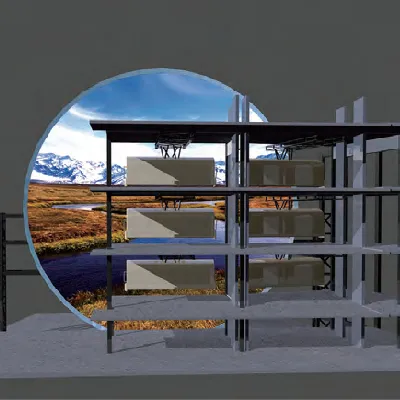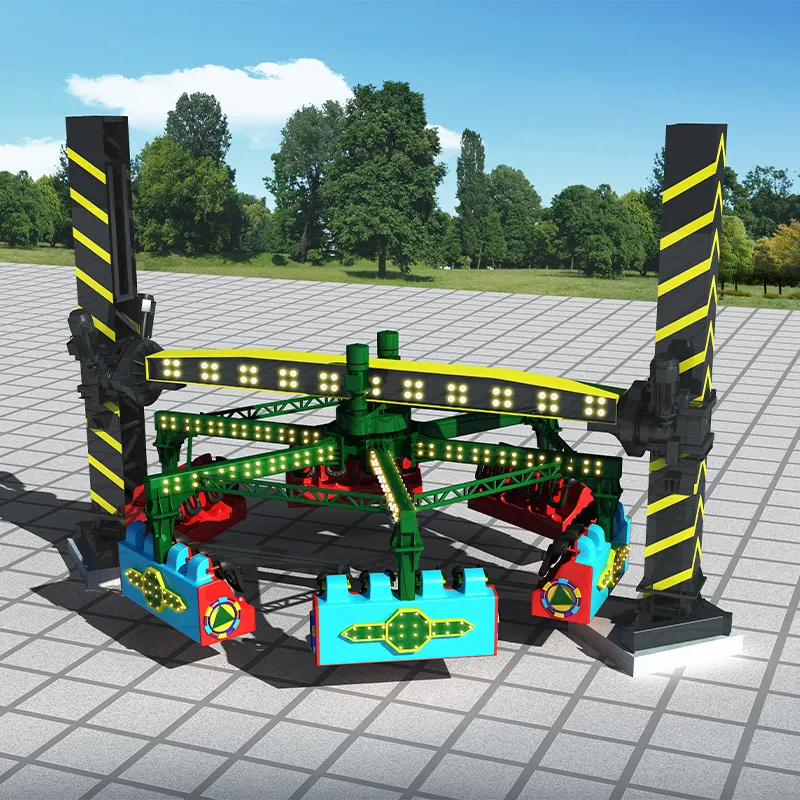Extreme Rides Ultimate Extreme Thrill & Theme Park Rides for Adrenaline Seekers
- Introduction to extreme rides
and their global popularity - Technological advancements shaping extreme thrill rides
- Comparative analysis of leading manufacturers
- Customization options for extreme theme park rides
- Global application cases: Success stories and key projects
- Safety innovations and regulatory considerations
- Future outlook of extreme rides and concluding insights

(extreme rides)
Introduction: The Surge of Extreme Rides in Modern Amusement Parks
In recent years, extreme rides have become the centerpiece of amusement park innovation, captivating adrenaline-seekers and pushing the boundaries of what’s possible in entertainment engineering. Research from the International Association of Amusement Parks and Attractions (IAAPA) signifies that the global market for extreme rides is projected to exceed $35 billion by 2027, reflecting an average annual growth rate of 5.6% since 2019. With the proliferation of record-breaking attractions, such as roller coasters exceeding speeds of 120 mph and towers climbing beyond 400 feet, visitors’ expectations continue to evolve towards ever more daring extremes. This surge is sustained by advancements in materials science, ride control, and immersive technologies, ensuring that extreme thrill rides consistently rank among the primary motivations for park attendance across North America, Europe, and Asia. As parks compete for global attention, the development and deployment of extreme theme park rides remain a pivotal differentiator in guest experience and revenue growth.
Engineering Excellence: Advances Fueling Extreme Thrill Rides
The rapid evolution of extreme amusement rides is underpinned by substantial progress in engineering and safety sciences. Contemporary ride manufacturers employ high-strength alloys, energy-absorbing components, and sophisticated real-time monitoring systems, which together allow for unprecedented speed, height, and maneuverability. For instance, the integration of magnetic launch technology has yielded launches from zero to 100 km/h in under 2 seconds, dramatically enhancing acceleration without excessive mechanical wear. Furthermore, the adoption of advanced computational modeling enables precise simulation of g-forces and stress factors, ensuring both the safety and exhilaration guests demand. Immersive elements, such as 4D visuals and synchronized audio, are now standard enhancements that blur the line between physical and digital thrills. It is this synergy of materials, electronics, and intelligent design that propels extreme theme park rides to new heights—delivering experiences previously thought impossible.
Comparative Manufacturer Analysis: Leaders in the Extreme Ride Market
Selecting the right extreme amusement ride supplier is crucial for parks aiming to capture market share. To better understand the competitive landscape, the following data-driven table compares leading global manufacturers based on key dimensions: product innovation, annual installations, average project completion time, and safety record.
| Manufacturer | Innovative Features | Annual Installations (2023) | Avg. Completion Time (months) | Reported Safety Incidents (2021-2023) |
|---|---|---|---|---|
| Intamin Amusement Rides | Magnetic launch, vertical drops, gyro swings | 32 | 14 | 0.004% |
| Vekoma Rides | 4D coasters, trackless tech, VR integration | 26 | 12 | 0.002% |
| Bolliger & Mabillard (B&M) | Inverted coasters, precision support, smooth rides | 18 | 16 | 0.001% |
| S&S Worldwide | Compressed-air launches, drop towers | 21 | 13 | 0.006% |
As illustrated, Bolliger & Mabillard achieves the lowest reported safety incident rate, while Intamin leads in the number of annual installations with many iconic extreme rides on their roster. The balance between innovation, reliability, and delivery speed remains central for decision-makers investing in new park attractions.
Customization: Tailoring Extreme Theme Park Rides for Unique Experiences
The capacity to offer bespoke solutions stands as a primary competitive edge among ride manufacturers. Modern parks increasingly seek customized extreme theme park rides that respond to site-specific constraints, local regulations, and distinctive branding themes. In response, vendors now provide modular construction methods, interchangeable seat configurations, and adaptable tracks that allow for post-installation modifications and seamless integration with digital storytelling features. This flexibility extends to the integration of proprietary media, synchronized effects, and differentiated ride vehicles to ensure a one-of-a-kind guest experience—and to support seasonal events, marketing campaigns, or local partnerships. For instance, a renowned park in the Middle East leveraged a flexible launch design to create North Africa's longest and fastest coaster, while a European operator employed themed ride skins and lighting systems to reflect regional folklore, boosting both repeat visitation and social media engagement rates.
Success Stories: Application Cases of Extreme Amusement Rides Worldwide
Examining real-world successes reveals the transformative impact of deploying extreme rides. In 2022, a flagship amusement destination in Japan introduced the world’s steepest drop coaster, which increased annual visitors by 18% and raised ride-specific merchandising revenue by $3.2 million. Similarly, North America’s latest hybrid coaster—combining steel and wood technologies—achieved a regional attendance record within its first year while reducing maintenance downtimes by 12% compared to prior signature rides. Emerging markets are catching up fast; in Southeast Asia, the launch of an immersive launch coaster, entirely themed around local mythology, drove a social media reach of over 10 million impressions within the first season. These applications underscore the capacity of extreme amusement rides not only to reshape physical infrastructure but also to unlock additional revenue streams and fortify park brand equity.
Safety Revolution: Technological and Regulatory Advances
Safety remains non-negotiable for extreme thrill rides, and recent years have witnessed a revolution in both regulatory frameworks and technical safeguards. Ride control systems now leverage redundant wireless sensors, real-time diagnostics, and automated evacuation protocols, achieving up to 45% faster response times in the unlikely event of anomalies. Moreover, rigorous international standards, set forth by ASTMF24 and EN 13814, guide design and operational practices. Independent certification and proactive maintenance analytics ensure that safety reviews are not mere formalities but dynamic, continually-updated checkpoints. Notably, industry data from the IAAPA indicates that the rate of significant incidents on certified extreme theme park rides is less than one in 50 million ride cycles—demonstrating the effectiveness of sector-wide safety commitments. Beyond compliance, parks are introducing on-ride safety education and digital briefings for guests to further reduce risks and elevate visitor confidence.
The Future of Extreme Rides: Next-Generation Experiences and Industry Impact
Looking ahead, the evolution of extreme rides is set to accelerate with the rise of artificial intelligence-driven personalization, energy-efficient propulsion systems, and cloud-based predictive maintenance platforms. The relentless pursuit of higher speeds, tighter inversions, and boundary-blurring immersion will transform guest engagement in ways previously unattainable. Manufacturers are collaborating across continents to deliver rides that harness renewable materials and minimize environmental footprints, reflecting the growing significance of sustainable shared experiences. As parks race to distinguish themselves in an increasingly crowded leisure landscape, the strategic investment in extreme amusement rides stands as both a business imperative and a testament to the enduring allure of adventure. Ultimately, the convergence of technology, creativity, and safety guarantees that extreme thrill rides will continue to captivate and inspire far into the future, shaping the cultural and economic fabric of recreation worldwide.

(extreme rides)
FAQS on extreme rides
Q: What are extreme rides?
A: Extreme rides are adventurous amusement attractions designed to deliver high levels of thrill and excitement. They often feature rapid movements, high speeds, and intense sensations. These rides appeal to adrenaline seekers.Q: What makes an extreme thrill ride different from regular amusement rides?
A: Extreme thrill rides typically have faster speeds, higher drops, and more intense motion than regular rides. They are engineered to push the limits of physical and psychological thrill. Riders experience stronger G-forces and more dramatic sensations.Q: What are some popular examples of extreme theme park rides?
A: Some famous extreme theme park rides include roller coasters like Kingda Ka, Top Thrill Dragster, and the X2. These rides are known for steep drops, rapid acceleration, and unique ride elements. Each offers a one-of-a-kind, adrenaline-pumping adventure.Q: Are extreme amusement rides safe?
A: Yes, extreme amusement rides are subject to strict safety standards and regular inspections. Maintenance and safety protocols are rigorously followed in reputable theme parks. However, riders should always follow posted guidelines and health warnings.Q: Who should avoid going on extreme rides?
A: People with certain medical conditions, such as heart issues or back problems, should avoid extreme rides. Pregnant individuals and those uncomfortable with high speeds or heights are also advised not to ride. Always read each ride’s safety warnings before participating.-
Large Amusement Equipment | Quality Park Rides for SaleAug.21,2025
-
Premium Theme Park Equipment for Sale | Rides & SuppliesAug.19,2025
-
Flume Ride-Hebei Zhipao|Thrilling Water Coaster&Amusement EquipmentAug.18,2025
-
Bolter With High Torque And Low Noise - Hebei Zhipao Amusement Equipment Manufacturing Co., Ltd.Aug.18,2025
-
Bolter With High Torque And Low Noise - Hebei Zhipao Amusement Equipment Manufacturing Co., Ltd.Aug.18,2025
-
Bolter With High Torque And Low Noise - Hebei Zhipao | High Torque, Low NoiseAug.18,2025
